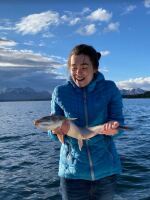Fifty-one million sockeye are forecast to return to Bristol Bay this summer.
If that holds, commercial fishermen will be able to harvest around 37 million reds. That’s 13% more than the average harvest of the past decade.
But concerns remain about the numbers of Chinook, or king salmon, in the Nushagak District, on the west side of Bristol Bay, and that tasks the biologists who manage the fishery with a complicated balancing act.
Faced with another huge sockeye run this summer, managers in the Nushagak District say they will try to allow fishermen to harvest the sockeye and also conserve Chinook.
Tim Sands, the district's area management biologist, describes the job as trying to walk a fine line between “getting as many kings up the river as we can, but still provide opportunity to harvest sockeye salmon.”
For years, biologists around the state have wrestled with declining numbers of Chinook, fish that are central to subsistence ways of life across Alaska, and also targeted by sport fishermen. Since 2007, the state’s Chinook runs have consistently declined, forcing managers to restrict or close fishing in certain areas.
A stark example: the Chinook run to the Chignik River. Last year, just under 1,300 fish returned, which is below the minimum escapement. Both state and federal managers restricted subsistence fishing for Chinook in July, and residents struggled to get enough fish.
In the Nushagak District, managing harvest is tough because Chinook and sockeye runs overlap, so when the sockeye harvests increase, so does incidental Chinook bycatch.

The Nushagak is the only commercial fishing district in Bristol Bay that still counts the Chinook runs, which can vary widely from year to year. For the past two years, the run hasn't met its minimum escapement of 55,000. That means too few fish have reached the spawning grounds for the run to be sustainable. In 2019, escapement was roughly 47,880. Last year, it was just over 43,000.
Fish and Game has acknowledged that its counting methods are designed to count sockeye, not Chinook, so it likely isn’t providing an accurate estimate of the king run. The department counts fish with a sonar, which is designed to cover the areas closer to shore, where sockeye swim. Chinook tend to swim in deeper water toward the center of the river.
Last June, managers postponed commercial fishing in the Nushagak District for days to allow more kings to escape upriver. In doing so, they let hundreds of thousands of sockeye swim through the district unharvested. This summer, the commercial and sport fish divisions will work to conserve as many Chinook as possible, according to Sands, the management biologist.

“Hopefully more than the minimum of kings up the river," he said. "So it’s going to be one of those day-by-day, looking at things, evaluating the information we have and trying to make the best decision we can with the information we have.”
In other areas of the bay, managers don’t count Chinook escapement anymore, but they do count incidental harvest. Last summer, the Chinook harvest across the bay was the lowest on record, at 10,000 fish.
It’s not just the Chinook runs that are declining; the size of the fish is also shrinking.
A study in the journal Nature Communications shows their body length has declined by 8% over the past six decades.
Daniel Schindler is a professor at the University of Washington who has researched salmon in Bristol Bay for decades. He said Chinook are returning to spawn at younger ages, particularly in western Alaska rivers.
“What we’re seeing is that the oldest, biggest fish are disappearing, or their body sizes are getting smaller at an accelerating rate," he said. "Particularly during the last 10 or 15 years, when fishery pressure has been relatively low compared to where it was 20, 30 years ago.”
Schindler said climate change in the Pacific Ocean may slow their growth. But he said research indicates that if fish grow more slowly in the ocean, they return to freshwater later.
“That’s not what we’re seeing," he said. "We’re seeing them come back to spawn at earlier ages. So that does suggest that there’s increased mortality on the oldest, biggest fish.”
A lot of factors can affect salmon survival. The state has said the overall declines are likely due to more fish dying out in the ocean. The decline in bigger fish could also be due to more predators targeting them.
Still, Schindler said, salmon are resilient. Chinook can rebound if their habitat quality remains intact, and if enough fish are allowed to pass through fisheries to spawn during years of low returns.
Contact the author at isabelle@kdlg.org or 907-842-2200.






